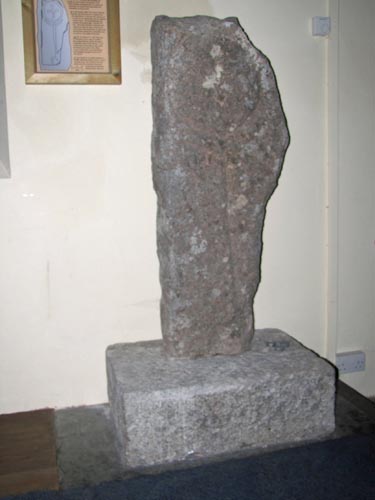 Location: The
cross has now been set up on a plinth inside Belstone Church for
safekeeping.
Location: The
cross has now been set up on a plinth inside Belstone Church for
safekeeping. O/S Grid Ref: SX/61937/93475 Longitude/Latitude (Degrees+/-): -3.95738/50.72444 Map location: Click here to view map. Purpose: Not known. Size: The stone is 4 feet 3 inches (1.30 metres) tall and 1 foot 8½ inches (0.52 metres) across, at its widest point. The incised cross is 10 inches (0.25 metres) high and 8 inches (0.20 metres) wide, within an incised circle 15 inches (0.23 metres) in diameter. Information:
William Crossing writes that this
stone was found at the church in 1861, when some steps leading to the
vestry were taken down. It was then taken to the In a village such as Belstone, one would have expected to see a village cross. Whether or not one has ever existed is open to speculation, but no trace of such a cross can be found at the present time. Certainly this inscribed stone was never a cross in the accepted sense, but it is obviously quite ancient and may well have originally served as the lid to a stone coffin or sarcophagus. It is badly damaged in that a large piece on the lower right hand side of the stone has broken away and is missing. The incised cross, which is of the Celtic design, is situated towards the top of the stone and is enclosed in an incised circle. There are also traces of larger incised cross below this with a vertical shaft and curved arms, which form the shape of an arc. The church, which is dedicated to St Mary, is in the centre of the village nestling behind the village inn, appropriately named: ‘The Tors Inn". Reports dating back to the mid 19th century show that the church was in a very bad state of repair at that time. These show that there were panes of glass missing from the windows and the roof was leaking, with the consequence that the inside of the church was very damp and dirty. All the woodwork was beginning to rot, the bible and hymn books were falling apart and the bells were unsafe. There were even reports of poultry straying into the entrance porch. Something had to be done and, in 1881, a complete restoration was undertaken at the substantial cost of £800. Almost the whole of the interior had to be gutted and replaced with new. This was quite a drain on the resources of a small rural parish and the result is that we now see a plain but pleasant interior to the church. Belstone is an interesting village, where the borders of the moor seem to encroach right into the centre of the village itself. There are several other interesting features within the village, the most notable of which are briefly described below:
On the village green itself is a large square memorial stone with a rusty metal pole, which served as a lamp-post, affixed to the top. The stone was erected to commemorate the Coronation of King George V and the following inscription is engraved on its eastern face: "GRV 22 V1 1911". More recently, the opposite face has been inscribed: "E II R 1952-1977", in celebration of Queen Elizabeth II’s Silver Jubilee in 1977. Also near the village
green is small pound, enclosed within a stone wall, with a wooden gate at
the front. A little plaque on the gate gives a brief history of the pound,
as follows: "Belstone Pound: Quite near the pound
are the village stocks, which have just a single pair of holes to hold one
person. Obviously a very law abiding village! There is a square stone
situated right behind the
|